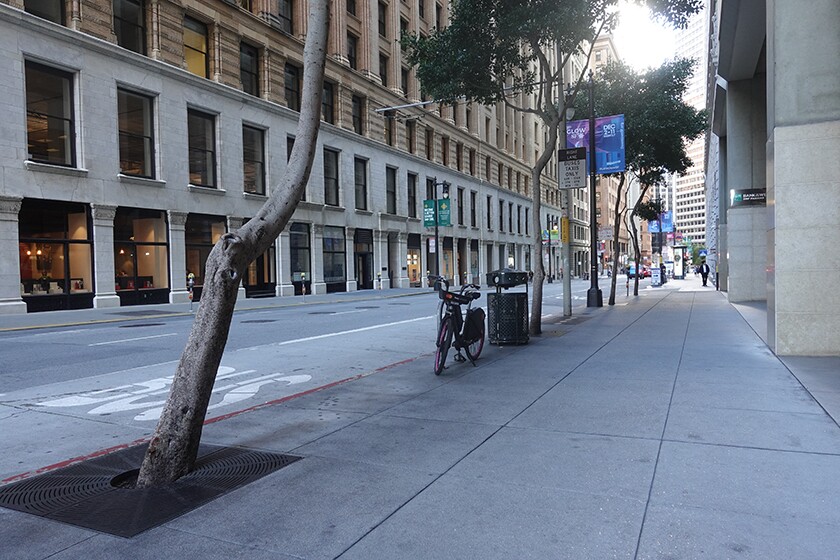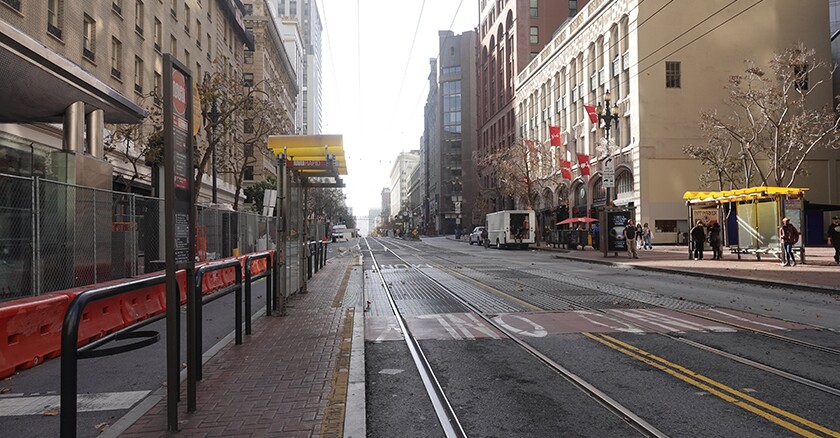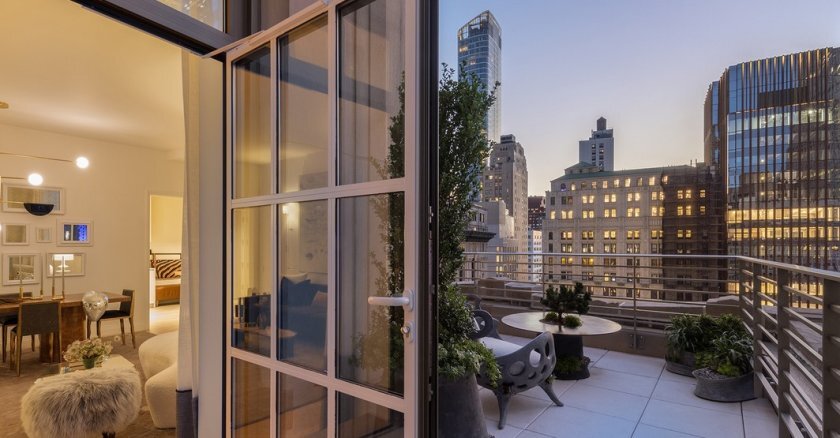Verkler’s shop is half a block from Salesforce Tower, the second-tallest building on the West Coast and headquarters of San Francisco’s largest private employer. It wasn’t great news for the neighborhood when Salesforce announced it was laying off 8,000 people and cutting back on office space at the beginning of the year. The mass layoffs announced in recent days by Amazon, Microsoft, Alphabet (Google’s parent company) and Meta (Facebook and Instagram), while certainly not all impacting San Francisco directly, aren’t a good sign for the city either. Tech companies make up nearly a third of the city’s private-sector payrolls. “It’s not the first time that I have wished San Francisco’s economy was a little more diversified than tech,” says Supervisor Matt Dorsey.
San Francisco already suffers an all-time record office vacancy rate of 27.6 percent. Meta has just put up 34 stories of office space — 435,000 square feet, enough space for 2,000 workers — for sublease.
Even before the tech slowdown, San Francisco’s downtown was as empty as any city’s in the country. Its heavy concentration of technology and finance companies were among the first to embrace the move to remote work. The nature of their businesses has made them the most likely to remain remote. That turned out to be great for the city’s health — San Francisco has had one of the lowest COVID-19 death rates in the country — but terrible for its economy. Already, the city is facing a $728 million shortfall — more than 10 percent of the general fund budget — over the next two fiscal years.

The office recession is happening everywhere. Around the country, with rare exceptions such as Austin, Miami and Salt Lake City, downtowns are notably emptier in nearly every city. Retail and restaurant spending in Boston’s Financial District was down 20 to 25 percent last year, compared to 2019. The number of workers showing up downtown remains more than 40 percent below pre-pandemic levels in New York, Philadelphia and Washington. The number of workers showing up in Pittsburgh’s downtown is down by half. One Los Angeles office tower just went on sale asking for half its sales price back in 2015.
Things are bound to get worse, suggests Stijn Van Nieuwerburgh, a professor of real estate and finance at Columbia University. Two-thirds of pre-pandemic leases have not yet come up for renewal, meaning many offices are empty but still being paid for. Across the country, the number of new leases being signed has fallen more than 50 percent. “The second shoe has yet to drop on the office market, with leases that have not come up for renewal yet,” Van Nieuwerburgh said during a webinar hosted by the Volcker Alliance and the Penn Institute for Urban Research. Retail, he notes, is no better.
Van Nieuwerburgh is co-author of a study showing that commercial office space around the country is on track to lose $413 billion worth of value. “We’re going through a major revolutionary change that will take decades to play out,” he said. “It will be a long and painful transition, not unlike deindustrialization.”
Three-Quarters of the Economy
By most measures — office key swipes, cellphone tracking data, population loss — San Francisco has taken the biggest hit. All the factors that make Americans more likely to work remotely — not just working with computers but long commute times; expensive housing; a highly educated workforce; and liberal politics — are conspiring against the city now.
Meta isn’t the only tech company surrendering its lease. Other tech firms including Twitter and Adobe have scratched local jobs. Downtown isn’t helped by rising interest rates and construction costs. If downward pressure on rents continues, the city will lose 35 percent of its commercial property tax revenue by 2028, according to Ted Egan, the city’s chief economist.
The city’s tourism sector still hasn’t recovered either, thanks in part to diminished travel from China and other Asian countries. Hotels remain half-empty. San Francisco relies heavily on conventions, which have yet to bounce back. VMware Explore, a big tech conference that drew 10,000 people to the city last year, won’t be coming back this year.
The Bay Area in general and San Francisco in particular have been among the nation’s major population losers during the pandemic. With wealthier people moving out, the Bay Area saw the country’s largest drop in household income between 2019 and 2021. For all the talk about turning downtown office towers into forests of condos, the demand isn’t there. The downtown condo market is the worst in the city. Housing prices in the city as a whole fell 13.3 percent last year, with at least one real estate forecast predicting San Francisco’s housing prices are set to decline the most in the country this year. Veritas, the largest landlord in the city, just defaulted on a $448 million loan.
Even though fewer commuters are coming into the city, a larger share are driving, and there aren’t enough parking spaces to accommodate them. With federal aid running out, BART and other local transit agencies are warning about severe cutbacks, with BART talking about running weekday trains on a frustratingly sparse hourly schedule, while San Francisco’s Muni bus and light rail system threatens potential cuts of 75 percent from pre-pandemic service levels.

San Francisco depends on office activities to generate nearly three-quarters of its GDP. There’s no scenario under which the city will be back to normal by 2026, Egan says. “We still have a lot of vacancies because there are no new businesses starting out,” he says. “Also, according to (real estate agency) JLL, the best it’s going to be in the next five years is as bad as the previous worst it’s ever been.”
Breed, like many other mayors, is hoping that significant amounts of office space downtown can be converted into housing. She’s also pushing for more spaces to be used for biotech. “A lot of people are looking at this as an opportunity to reinvent what San Francisco is,” says Sujata Srivastava, San Francisco director of SPUR, an urban planning nonprofit, pointing to potential improvements in areas such as transit, safety, child care and mixed-use development. “We have to make it a place where people want to be and not a place where people have to be.”
Office conversions are a lot easier — and certainly much cheaper — to talk about than make happen. And solving intractable problems in areas such as homelessness and crime won’t be made easier by declining resources. Still, officials around City Hall remain optimistic that the road ahead, while bumpy, is still leading to good places. San Francisco has been reinventing itself since Gold Rush days, often facing worse overall economic declines than anything happening right now. Much of the city is fantastically beautiful, it’s blessed with a mild climate and San Francisco remains home to one of the best-educated workforces in the country.
Maybe, just as the tech companies are now laying people off following unsustainable expansions during the pandemic, San Francisco and other superstar cities will go through a period of ultimately welcome right-sizing after their feverish growing during the 2010s.
Aaron Peskin, the president of the Board of Supervisors, points out that his district includes not only much of the city’s downtown, but the sites people around the world associate with San Francisco: Fisherman’s Wharf and Chinatown, the ferry to Alcatraz and Lombard Street, the so-called crookedest street in the world. “Ninety percent of this district is on fire,” Peskin says. “There’s a doughnut hole that’s downtown that’s lagging behind. Downtown is definitely a challenge, but it’s not a weight that’s going to sink this town.”

Empty City Streets
Almost anticipating the emptiness to come, the city shut down Market Street, the main drag cutting diagonally through downtown, to private cars on Jan. 29, 2020, just before the start of the pandemic. The idea was to make it safer and emphasize public transit. At this point, it’s deserted, except for the occasional empty bus rumbling by. Market Street’s extra-wide sidewalks seem now like a mean joke.
In the Financial District, Montgomery Street is just as still. In the not-distant past, so many people walked up and down the street all day that it was easy to wonder whether anyone actually got any work done back at the office. These days, you can stand on a corner during a workday and spend minutes in a deep quiet before seeing a single person pass by. Platforms at the Montgomery Street BART station were once so crowded there was a risk people could fall off the platform and onto the track, Srivastava says. Now it just feels barren.
On a recent Friday afternoon, attorney Joe Crawford was one of only two people spotted wearing a suit and tie on Montgomery Street over the course of more than an hour. He had rarely worked from home before the pandemic. Now, he rarely comes in. He had a deposition that day and had also come in the day before to attend a settlement conference. Prior to that, he hadn’t bothered coming downtown for a month. “You never really want to go into the office when it’s a ghost town,” Crawford says.
There’s a “critical mass” issue as Verkler, the sandwich shop manager, says. People don’t go downtown because other people aren’t going downtown. There’s not much point in showing up if there’s no one to meet or even interact with. The incentives grow less as your favorite place for lunch closes its doors or your gym goes out of business.
And empty streets can feel unsafe. On the edges of downtown, it’s routine to see individuals selling drugs, not openly but flagrantly. Overdoses from fentanyl and other illegal drugs — which are a major problem all over the country — hit an all-time high in San Francisco in 2020. In fact, the number of deaths due to overdoses was much higher in the city in that first pandemic year than those caused by COVID-19.

None of these problems are exactly new, but people who never liked coping with traffic, street crime or a general sense of disorder downtown can simply stay home. “You had to go in, so everyone just sucked it up and went in,” says one resident. “People just put up with it because they wanted to have a job in tech. Now, they just don’t have to.”
The City Responds
The city and the downtown neighborhood association have tried to respond to these concerns with stepped-up police patrols, as well as a program featuring orange-jacketed “welcome ambassadors" who offer directions to tourists and tips about where they can charge their phones. The city’s public health approach to drug overdose, including strategies known as harm reduction that accept people will use drugs but try to reduce their risks, has helped bring down the number of overdose deaths by 14 percent over the past two years, even as they’ve continued to climb around the country as a whole.
Mayor Breed has called for crackdowns on crime in areas such as the Tenderloin. In 2021, she spoke bluntly about her frustration with “all the bulls--t that has destroyed our city.” Last June, San Francisco voters recalled District Attorney Chesa Boudin out of concern about the level of crime. “In some ways, the perception of safety can be an issue that’s sometimes worse than what the numbers would suggest,” Dorsey says.
But every crisis presents an opportunity, he notes. The silver lining among San Francisco’s struggles, Dorsey notes, is that “everything is on the table.” There’s a chance to rethink everything from tax rates to the way the city does contracting. And a place that’s notorious for its NIMBY-strong resistance to nearly all residential construction will be forced to become more open to housing, in part due to state mandates that will require San Francisco to build thousands of new units in the coming years.

Are Downtowns Necessary?
Downtowns grew with cities throughout the 19th and 20th centuries. With industrialization, workers left farms and came downtown to work in factories. People and commerce served to attract each other. It was convenient to have lawyers, accountants and other professional services near their clients. Downtowns became the hub of transit systems and centers of shopping. Suburbanization hurt cities, but thousands of office workers still made the trek into central business districts each day.
In this century, downtowns became magnets for young professionals and empty nesters. During the decade between the Great Recession and the pandemic, outsize shares of the nation’s economic activity took place within a limited number of ZIP codes in a relatively small number of cities. The Internet had already made remote work possible, but high-value companies — particularly in tech — liked having concentrated labor pools to draw from. Places such as San Francisco grabbed a disproportionate share of the nation’s wealth.
There’s still a question about whether what economists call agglomeration effects — having clusters of entities engaged in similar businesses located near each other — is a force that will eventually bring workers together again in downtowns. Dorsey will be happy to point you to studies indicating that productivity has declined during the pandemic and the remote-work revolution. “Do we believe that everybody was making a huge mistake spending $80 a square foot for San Francisco real estate when they didn’t need to?” asks Egan, the city’s economist. “I’m a little skeptical that it really is going to be permanent.”
But he concedes that the city has to assume that mass-scale remote work will be the state of play, at least for a while. The signs are all pointing that way. Egan himself has moved to Davis, about 75 miles northeast of City Hall, and does not drive in every day. The share of people working from home has remained stable for a long time now, while the share of online listings for jobs allowing remote or flexible schedules only continues to climb. Surveys of startups show that a large majority of them expect to remain remote. "My wife, an attorney, who has her own office that's a 10 minute walk from our residence, has learned she can do the same job at home with the cat in her lap," Peskin says.
There’s still debate about whether or how much remote work hurts productivity, but even some slipping might not be enough to drive people who don't want to go back to physical locations. Accommodating people in offices costs companies money — about $15,000 per head, according to Van Nieuwerburgh. “As long as a worker is not dramatically less productive, you can save a lot of money by letting workers work from home,” he says. “That’s a pressure that will only intensify as the recession looms.”

Commercial property owners are not yet ready to cut rents to bring the 28 percent vacancy rate back down to five percent. If and when that happens, downtown San Francisco will regain real competitive advantages as a draw for talent from all over the Bay Area, and indeed the world. But that assumes people will return to working in offices in force.
“At that point, you can start to think about building downtown, rather than imagining that it’s a blank slate, that you can start over,” Egan says. “Because I just don’t see anything happening until the offices get filled again.”
Related Articles














